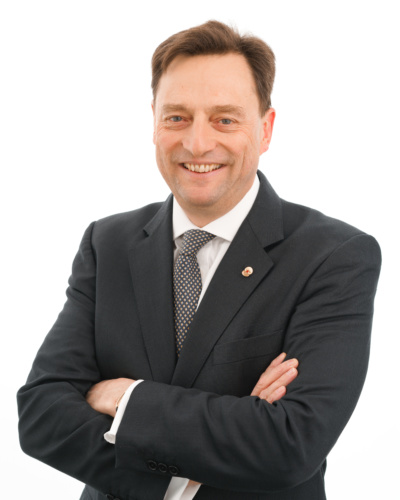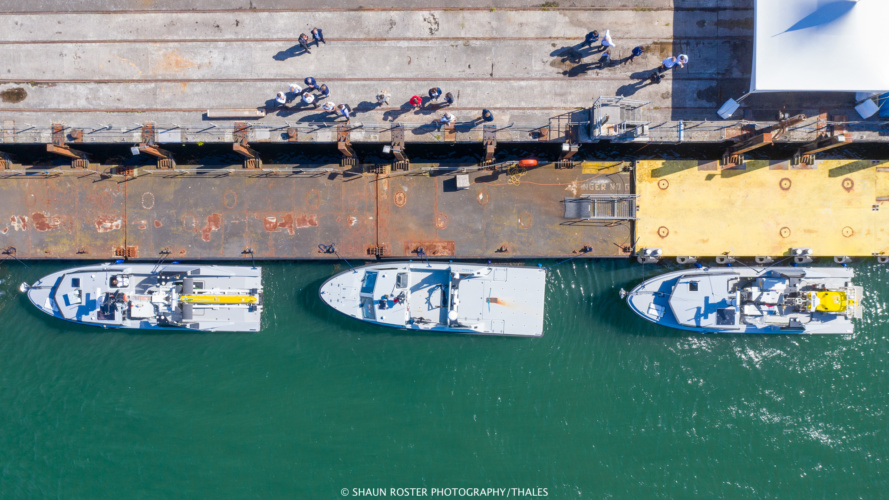Thales’ presence in the UK can be traced to Glasgow in the late 1880s when an engineer and a physicist responded to a tender from industry after the poor performance of artillery rangefinders during the Boer War.
The tender asked for improved equipment that could be operated by soldiers of ‘average intelligence’ and the two academics – who went onto form Barr & Stroud – cemented a relationship with the UK’s armed forces that continues to this day. Barr & Stroud’s range-finding technology was deployed on the Royal Navy’s first submarine and Thales has since gone on to provide periscopes, then optronic masts, to every single submarine in the Royal Navy.

“There are three original periscopes from that period left,” said Alex Cresswell, Chief Executive Officer and Chairman of Thales UK. “One is in the Thales foyer at Glasgow, the other is in the Maritime Museum and the third is at St Andrew’s Golf Club where you can look through it and view the first hole!”
Cresswell’s appointment in the UK follows several years as Executive Vice-President, Thales Land and Air Systems in France, and he is keen for engineering careers to be as appealing in Britain as they are across the English Channel.
“Having spent 10 years in France and seen at first-hand how they view and respect engineers in society, I think it’s critical we focus on our future,” he said. “We cannot keep losing the ‘best of the best’ engineers to careers in banking. Engineering and scientific careers also have to be appealing to everyone, regardless of ‘class’ or background.
“Without a doubt we in Thales want talented, commercially astute and innovative engineers. We would like to see greater diversity, but this starts much earlier in the educational system. I think STEM ambassadors have a massive role to play. You can only be inspired by what you see at an early age - and I speak from experience.”
Indeed, Cresswell’s journey to becoming an aeronautical engineer began with a childhood fascination for aeromodelling (a hobby funded by a paper round) and a visit with his grandmother to the National Air & Space Museum in Washington, which he says, ‘remains one of my favourite places in the world.’

Cresswell’s obvious enthusiasm is buoyed by the belief that science and technology provide considerable societal benefits and that the impact of Covid-19, whilst severe for many, is likely to present similarly advantageous challenges and benefits as we emerge from the pandemic
That said, Thales has not escaped disruption to production chains and projects and has had to introduce a Global Crisis Adaptation Plan to strengthen its resilience. The company’s civil aeronautics business – which generated sales of approximately €2.15bn in 2019 - recorded a 45 per cent sales slump in third quarter of 2020.
“After the 2008 crash, it took five years for the [civil aerospace] industry to recover and we could be looking at something similar,” Cresswell said. “And I think we’re going to see a much-changed rationale to travel with a higher emphasis on green issues and the environment.
“At one end of the spectrum, it could be airlines retiring the big aircraft...and at the other it will be the greater use of AI and technology to improve the green footprint of the industry,” he continued. “By combining AI with our expertise in trajectory prediction algorithms for flight management systems, it is possible to predict air traffic with a degree of reliability, and thus anticipate the decisions that will need to be made; improving factors such as cutting down on aircraft circling waiting to land, burning fuel, aircraft waiting on taxiways.”
The old model of graduate and PhD recruitment is being supplemented these days by really talented young people joining at a younger age and going on to get a degree through an apprenticeship route
According to Cresswell, the challenges and opportunities of a technology-led bounce back from Covid will very likely involve autonomy, AI, IoT connectivity, cyber security and big data.
He notes that the importance of data and algorithms to extract important information from vast quantities of data will grow, but a strong case will remain in the autonomous realm for keeping a human in certain decision-making loops. Furthermore, algorithms are inextricably linked to autonomy and trust in autonomy will be critical as new platforms and use cases emerge.
“The potential civil and military use of autonomy is massive and it’s not just an engineering challenge,” he said. “In the air, it is going to be overcoming the challenge of operating in the uncontrolled airspace – the 1,000ft ‘in line of sight’ area below.

“At Turnchapel, Plymouth we’ve invested in a centre to develop these maritime autonomous technologies. The most advanced is mine countermeasures (MMCM). Effectively, it’s taking the sailor out of the dull, dirty and dangerous and its proving highly effective.”
Early into the Covid-19 pandemic Thales and partners mobilised in civilian airspace to bring beyond visual line of sight (BVLOS) capabilities to drones delivering PPE and medical equipment from the Scottish mainland to a remote hospital on the Island of Mull. (The Engineer, April 2020).
“I think it demonstrated the positive role that unmanned technology can play in our society and hopefully represents a landmark step to accelerate its adoption,” Cresswell said.
A piloted aircraft with the potential to operate with a degree of autonomy is scheduled to enter service in the mid-2030s. The Tempest Future Combat Air System includes Thales as a team member and the platform’s proposed capabilities will make today’s military jets seem antiquated in comparison.
“We will explore how we will play a leading role in designing and securing the digital operating environment,” Cresswell said. “It’s not just a platform, it’s the ability to share and assimilate massive amounts of data in a trusted command structure and secure direct effects as a consequence.”

Getting Tempest airborne, keeping MMCMs afloat, and accommodating a greater number of unmanned and autonomous drones will require a fresh pipeline of talent and Cresswell concedes that companies will have to look beyond the conventional tertiary route. “The old model of graduate and PhD recruitment is being supplemented these days by really talented young people joining at a younger age and going on to get a degree through an apprenticeship route,” he said. “We have an excellent partnership with Manchester Met University for a degree apprenticeship that provides students with a solid academic foundation in Computer Science/Software Engineering, along with real life project and workplace skills.”
Cresswell joined Thomson CSF (latterly Thales) in 1992 with the intention of leaving after three years. He remained due to the ‘huge variety of meaningful projects’ he was responsible for and is confident that the sheer pace and scale of change will help inspire the next generation of engineering talent. “We’re the eyes and ears of the UK Dreadnought Class nuclear submarines… we’re going to play a key role in the building of the habitat and refuelling modules for the Gateway space station as part of the Artemis mission to land on the Moon….we’re going to Mars as part of the Exomars mission in 2022 where our sensors will play a central role in the mission to find signs of life. “Just as I did, engineers will want to come and work on these sorts of challenges. It’s a perennial, personal thing: to contribute and make a difference.”










CCC Report Finds UK Climate Targets Still Within Reach
In 1990 67% of the UK´s electricity came from coal-fired power stations and even without renewables the transition to gas was a major contributor to...